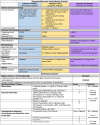Practical Guidance for Clinical Microbiology Laboratories: Microbiologic diagnosis of implant-associated infections
- PMID: 38506553
- PMCID: PMC11237642
- DOI: 10.1128/cmr.00104-23
Practical Guidance for Clinical Microbiology Laboratories: Microbiologic diagnosis of implant-associated infections
Abstract
SUMMARYImplant-associated infections (IAIs) pose serious threats to patients and can be associated with significant morbidity and mortality. These infections may be difficult to diagnose due, in part, to biofilm formation on device surfaces, and because even when microbes are found, their clinical significance may be unclear. Despite recent advances in laboratory testing, IAIs remain a diagnostic challenge. From a therapeutic standpoint, many IAIs currently require device removal and prolonged courses of antimicrobial therapy to effect a cure. Therefore, making an accurate diagnosis, defining both the presence of infection and the involved microorganisms, is paramount. The sensitivity of standard microbial culture for IAI diagnosis varies depending on the type of IAI, the specimen analyzed, and the culture technique(s) used. Although IAI-specific culture-based diagnostics have been described, the challenge of culture-negative IAIs remains. Given this, molecular assays, including both nucleic acid amplification tests and next-generation sequencing-based assays, have been used. In this review, an overview of these challenging infections is presented, as well as an approach to their diagnosis from a microbiologic perspective.
Keywords: biofilms; cardiac implantable electronic device infection; medical implants; microbiologic diagnosis; periprosthetic joint infection; prosthetic valve endocarditis.
Conflict of interest statement
M.A.A. is a consultant for Cytophage Technologies Ltd., as well as BioFire USA and bioMérieux Canada. R.P. reports grants from MicuRx Pharmaceuticals and BioFire USA. R.P. is a consultant to PhAST, Day Zero Diagnostics, Abbott Laboratories, Sysmex, DEEPULL DIAGNOSTICS, S.L., Netflix and CARB-X. In addition, R.P. has a patent on Bordetella pertussis/parapertussis PCR issued, a patent on a device/method for sonication with royalties paid by Samsung to Mayo Clinic, and a patent on an anti-biofilm substance issued. R.P. receives honoraria from Up-to-Date and the Infectious Diseases Board Review Course.
Figures



References
-
- Magill SS, Edwards JR, Bamberg W, Beldavs ZG, Dumyati G, Kainer MA, Lynfield R, Maloney M, McAllister-Hollod L, Nadle J, Ray SM, Thompson DL, Wilson LE, Fridkin SK, Emerging Infections Program Healthcare-Associated Infections and Antimicrobial Use Prevalence Survey Team . 2014. Multistate point-prevalence survey of health care-associated infections. N Engl J Med 370:1198–1208. doi:10.1056/NEJMoa1306801 - DOI - PMC - PubMed
-
- Lalani T, Chu VH, Park LP, Cecchi E, Corey GR, Durante-Mangoni E, Fowler VG, Gordon D, Grossi P, Hannan M, Hoen B, Muñoz P, Rizk H, Kanj SS, Selton-Suty C, Sexton DJ, Spelman D, Ravasio V, Tripodi MF, Wang A, International Collaboration on Endocarditis–Prospective Cohort Study Investigators . 2013. In-hospital and 1-year mortality in patients undergoing early surgery for prosthetic valve endocarditis. JAMA Intern Med 173:1495–1504. doi:10.1001/jamainternmed.2013.8203 - DOI - PubMed
Publication types
MeSH terms
LinkOut - more resources
Full Text Sources

